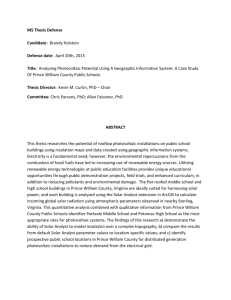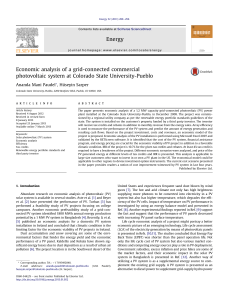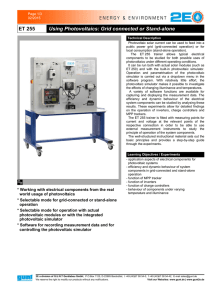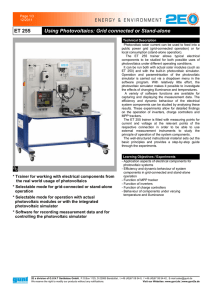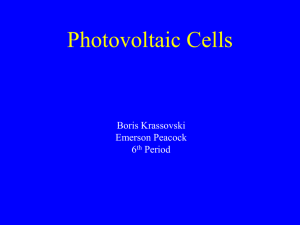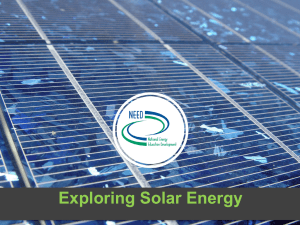Chapter 29: PHOTOVOLTAIC SYSTEMS
advertisement
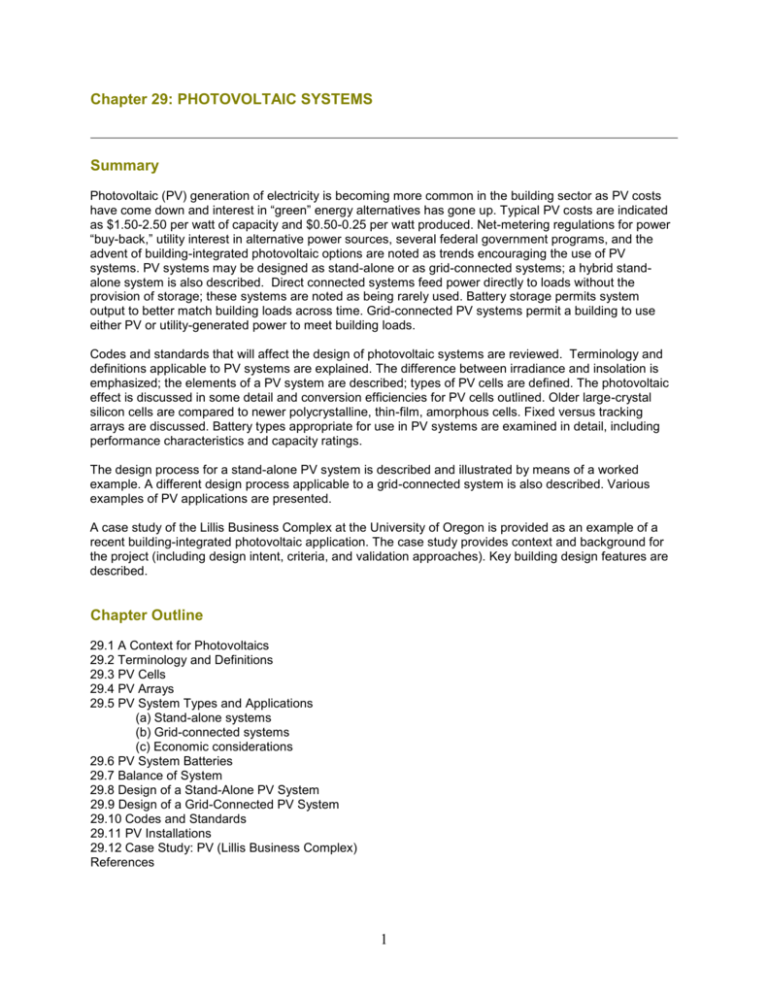
Chapter 29: PHOTOVOLTAIC SYSTEMS Summary Photovoltaic (PV) generation of electricity is becoming more common in the building sector as PV costs have come down and interest in “green” energy alternatives has gone up. Typical PV costs are indicated as $1.50-2.50 per watt of capacity and $0.50-0.25 per watt produced. Net-metering regulations for power “buy-back,” utility interest in alternative power sources, several federal government programs, and the advent of building-integrated photovoltaic options are noted as trends encouraging the use of PV systems. PV systems may be designed as stand-alone or as grid-connected systems; a hybrid standalone system is also described. Direct connected systems feed power directly to loads without the provision of storage; these systems are noted as being rarely used. Battery storage permits system output to better match building loads across time. Grid-connected PV systems permit a building to use either PV or utility-generated power to meet building loads. Codes and standards that will affect the design of photovoltaic systems are reviewed. Terminology and definitions applicable to PV systems are explained. The difference between irradiance and insolation is emphasized; the elements of a PV system are described; types of PV cells are defined. The photovoltaic effect is discussed in some detail and conversion efficiencies for PV cells outlined. Older large-crystal silicon cells are compared to newer polycrystalline, thin-film, amorphous cells. Fixed versus tracking arrays are discussed. Battery types appropriate for use in PV systems are examined in detail, including performance characteristics and capacity ratings. The design process for a stand-alone PV system is described and illustrated by means of a worked example. A different design process applicable to a grid-connected system is also described. Various examples of PV applications are presented. A case study of the Lillis Business Complex at the University of Oregon is provided as an example of a recent building-integrated photovoltaic application. The case study provides context and background for the project (including design intent, criteria, and validation approaches). Key building design features are described. Chapter Outline 29.1 A Context for Photovoltaics 29.2 Terminology and Definitions 29.3 PV Cells 29.4 PV Arrays 29.5 PV System Types and Applications (a) Stand-alone systems (b) Grid-connected systems (c) Economic considerations 29.6 PV System Batteries 29.7 Balance of System 29.8 Design of a Stand-Alone PV System 29.9 Design of a Grid-Connected PV System 29.10 Codes and Standards 29.11 PV Installations 29.12 Case Study: PV (Lillis Business Complex) References 1 Key Concepts photovoltaic or PV (as a “green” means of generating electricity) net metering (as a photovoltaic power billing approach) stand-alone versus grid-connected PV systems (as alternative design approaches) avoided cost (as a means of establishing utility payments for PV power) PV system terminology (as a means of fostering design team communication) insolation versus irradiance (as distinct metrics of solar availability) photoelectric effect (the reason PV cells generate electricity) building-integrated photovoltaics or BIPV (as an emerging PV installation trend) Terminology and Metrics Important Terminology rectifier battery (lead-acid, lead-calcium, lead-antimony, nickel-cadmium; sealed; shallow-cycle, deepcycle) photovoltaic (PV) cell module panel array thick-crystal thin-film polycrystalline amorphous stand-alone PV grid-connected PV interactive PV system hybrid stand-alone PV direct-connected PV system building-integrated photovoltaics (BIPV) inverter (power conditioning unit, power conversion system) safety cutoff kWh meter PURPA (Public Utilities Regulatory Policy Act) avoided cost net metering insolation irradiance energy power tilt angle fixed array tracking array (single axis, dual axis) charge controller Important Metrics watts per square foot (irradiance, solar power received) watt-hours per square foot (insolation, solar energy received) nanometer (wavelength) 2 electron-volt (a measure of energy at the atomic scale) efficiency (dimensionless) A-H (ampere-hour; battery capacity) Links to Resources U.S. Department of Energy, Energy Efficiency and Renewable Energy, Photovoltaics: http://www.eere.energy.gov/solar/photovoltaics.html Florida Solar Energy Center, Photovoltaics: http://www.fsec.ucf.edu/pvt/pvbasics/ Sandia National Laboratories, Photovoltaics: http://www.sandia.gov/pv/ Solar Decathlon Competition http://www.eere.energy.gov/solar_decathlon/ 3

